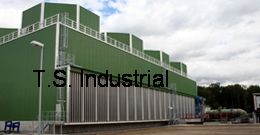Why wet cooling?
Wet cooling offers an outstanding performance by taking full advantage of the ambient air humidity. Wet cooling, also called evaporative cooling, enables to obtain a re-cooled water temperature at least 20°C lower as compared to a radiator. As turbine output and hence power plant output increases by 0.3 to 1 % per degree of better cooling, wet cooling is a technology that can generate outstanding fuel saving and carbon emission reduction.
Does wet cooling use a lot of water?
One to two percent of the water is evaporated only. For this reason, a closed loop circuit with a cooling tower needs make-up water from an external source (river , lake, sea).
The make-up low depends on the raw water hard-ness and is limited to maximum 4% in most cases.The water that is not evaporated is returned to the external source. During its transit in the cooling system, the water is never in contact with any luid from the factory process and therefore cannot be polluted by it.
Can a cooling tower be more advanta-geous than a once-through sea cooling?
A case by case eco-nomic and impact study should be done for each case comparing once-through and closed loop cooling. Conclusion will probably show how cooling tower would be much more attractive!
Numerous installations and equipment–more than 5400 references–operating world wide in a wide range of industrial plants are evidence of our capabilities and experience. Whatever the industry you name, We has supplied cooling towers for it: power plant, reinery and down stream petro-chemical plant, fertiliser, paper industry, steel mill, sugar mill, zinc smelter and other metallurgical installation, chemical plant, etc.
Key Words: Fin tubes, Finned tube, Heat exchanger, Wet Cooling Systems


